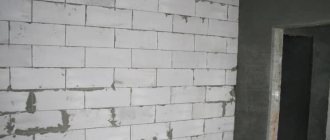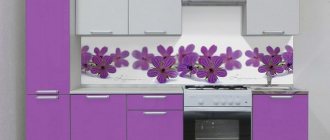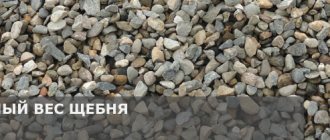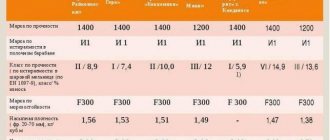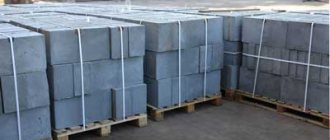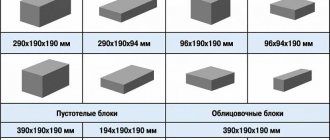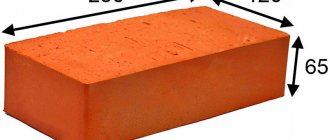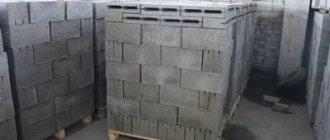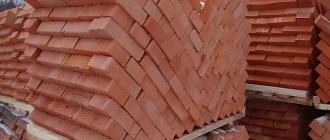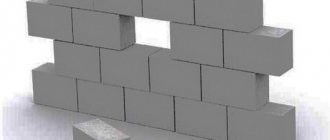The introduction of advanced technologies in the construction industry allows the average consumer to move away from the usual bricks, turning their attention to more affordable and easy-to-install aerated concrete. This is a modern composite material that has enough advantages to find its niche in the private, mass civil and industrial sectors. A prominent representative of products of this type is the INSI block, mass-produced at the Autoclaved Concrete Plant.
Reducing labor intensity while maintaining and improving the quality of the finished product are the advantages that composites, such as INSI gas block, have. Unlike homogeneous brick, which is a baked clay mass of regular rectangular shape, the new material consists of several components, where each plays its role:
1. Portland cement, sand, water are the basic elements of any concrete that form the bulk of the mixture.
2. Lime or gypsum is the main component for a highly alkaline solution that reacts with the foaming agent.
3. Aluminum (in the form of fine powder or paste) - used to activate gas formation in volume.
The finished mixture, which has a paste-like structure, similar in consistency to liquid sour cream, is poured into the frame, where it gradually hardens. The main feature of aerated concrete produced by INSI is the gas formation that occurs in the mass. The components form a lime solution, which in turn reacts chemically with aluminum, releasing hydrogen. At the same time, the entire mixture foams, increases in volume, and when hardened, forms a porous structure. Individual cells do not physically communicate with each other, but have an approximately spherical shape with a diameter of 1 to 3 mm.
Aerated concrete blocks are obtained by cutting a more or less frozen mass into separate “cubes”. After this, autoclave processing occurs, which gives final strength to the workpiece. The process conditions involve the use of compressed water vapor at a pressure of at least 0.9 MPa and a temperature of up to 175 ºС.
Information on the purpose of the calculator
The online calculator for aerated concrete blocks is designed to perform calculations of the building materials needed for the construction of walls of houses, garages, utility and other premises. The calculations can take into account the dimensions of the building's gables, door and window openings, as well as related materials, such as mortar and masonry mesh. Be careful when filling out the data, pay special attention to the units of measurement.
When filling out the data, pay attention to the additional information with the sign ❗
Aerated concrete blocks are one of the types of cellular concrete, with air pores evenly distributed throughout the volume. The more evenly distributed such pores are, the higher the quality of the concrete itself.
The production of aerated concrete in a factory is a rather complex process. In addition to cement and sand, chemical gas-forming additives are used in production, the amount of which must be calculated with very high accuracy. After all the components are mixed, the whole mass of aerated concrete is poured into special forms, in which it increases in volume due to the release of gases.
The main feature of the production of cellular concrete is the hardening of poured concrete under pressure in special autoclave chambers. This is necessary so that the air pores are distributed evenly throughout the entire volume. The production of high-quality aerated concrete without such chambers is impossible. After gaining the required strength, the entire array is cut into blocks of the required sizes.
Before purchasing aerated concrete blocks, you need to calculate their quantity as accurately as possible using a calculator so that you do not have to overpay for excess material.
Just like other types of blocks, aerated concrete blocks are divided according to density into:
- Structural
- for the construction of load-bearing walls. - Structural and thermal insulation
- for the construction of load-bearing walls of low-rise buildings. - Thermal insulation
- for the construction of self-supporting walls.
Due to their characteristics, such as light weight, good thermal insulation, ease of machining, aerated concrete blocks are a very popular building material, and continue to rapidly gain popularity. But do not forget that good thermal insulation of this material is achieved only if all the rules of construction from aerated concrete blocks are observed, such as masonry with special masonry adhesive, additional protection from precipitation, good waterproofing and vapor barrier, as well as correct calculation of the required wall thickness, in depending on the weather conditions of each specific region.
The disadvantages of this material include:
- High fragility.
- The need to use special devices for attaching hanging objects to walls.
- High water absorption, resulting in an increase in the declared thermal conductivity.
- Strong dependence of thermal insulation characteristics on the strength of the blocks.
- Using relative characteristics for advertising purposes.
When choosing materials for building a house, be sure to consult with independent specialists in your region. Don't believe loud advertising claims.
The following is a complete list of calculations performed with a brief description of each item of the calculator. If you haven't found the answer to your question, you can ask it in the comments below the article.
General information on the calculation results
1. Building perimeter
— The total length of all walls taken into account in the calculations.
2. Total masonry area
— The area of the outer side of the walls. Corresponds to the area of the required insulation, if provided for by the project.
3. Wall thickness
— The thickness of the finished wall, taking into account the thickness of the mortar joint. May differ slightly from the final result depending on the type of masonry.
4. Number of blocks
— The total number of blocks required to build walls according to the given parameters.
5. Total block weight
— Weight excluding mortar and masonry mesh. Just like the total volume, it is necessary to select a delivery option.
6. The amount of mortar for the entire masonry
— The volume of mortar required for masonry. The volumetric weight of the solution may vary depending on the ratio of components and additives introduced.
7. Number of rows of blocks including seams
— Depends on the height of the walls, the size of the material used and the thickness of the masonry mortar. Excluding gables.
8. Quantity of masonry mesh
— The required amount of masonry mesh in meters. It is used to reinforce masonry, increasing the solidity and overall strength of the structure. Pay attention to the number of reinforced rows; by default, the reinforcement of each row is indicated.
9. Approximate weight of finished walls
— Weight of finished walls, taking into account all building blocks, mortar and masonry mesh, but excluding the weight of insulation and cladding.
10. Load on the foundation from the walls
— Load without taking into account the weight of the roof and ceilings. This parameter is necessary to select the strength characteristics of the foundation.
To calculate the material for partitions, you need to start a new calculation and indicate the length of only all partitions, the thickness of the walls to the floor of the block, as well as other necessary parameters.
Technical specifications
The products of the Autoclaved Concrete Plant and other domestic manufacturers in this area are regulated by the state standard GOST 31360-2007 (GOST 21520-89). This document, among other things, normalizes the technical characteristics of the INSI block: shape, specific gravity, thermal conductivity, shrinkage, frost resistance, vapor permeability, strength.
1. Shape of finished products.
As already reported above, after the mixture has hardened (before the autoclave), the INSI block is not the ideal “cube” that is sold in the wholesale and retail trade networks. To ensure the manufacturability of the process, in accordance with GOST, aerated concrete is formed in the form of a slab or block blank. The differences between them are not only in dimensions, but also in the ratio of sizes:
- The block extends up to 625 mm with a width and height of 500×500 mm.
- The slab with a maximum length of 1.5 m has a cross section of 1.0 × 0.6 m.
In addition to these two options, aerated concrete blocks with a U-shaped cross-section are also produced. Their main purpose is the arrangement of monolithic stiffening belts, supports for beams, ceilings, mauerlats, and upper limiters for window and door openings.
The standard size of INSI blocks is achieved by cutting the frozen workpiece into individual elements. Their geometry may vary depending on the manufacturer, however, some generally accepted dimensions are used:
| Marking | Dimensions, mm | Note | ||
| Length | Width | Height | ||
| 100-500-2,5 100-600-3,5 | 625 | 100 | 250 | Classic straight block |
| 150-500-2,5 150-600-3,5 | 150 | Vertical face groove | ||
| 200-500-2,5 200-600-3,5 | 200 | Hand grooves + groove on ends | ||
| 240-500-2,5 240-600-3,5 | 240 | |||
| 300-500-2,5 300-600-3,5 | 300 | Two vertical grooves and recesses on the end walls | ||
| 400-500-2,5 400-600-3,5 | 400 | |||
| U-block 200 | 600 | 200 | 250 | U-type (custom order) |
| U-block 240 | 240 | |||
| U-block 300 | 300 | |||
| U-block 400 | 400 | |||
2. Specific gravity and strength.
One of the main indicators that INSI aerated concrete blocks have is their density. Since the finished product has a porous structure, its weight is significantly reduced in comparison with brick or ordinary concrete of the same volume.
Research results show that an aerated block has a specific gravity of about 400–600 kg/m3, which is almost 5 times less than that of concrete. At the same time, the finished INSI block has a strength of 2.5–7.5 N/mm2 (MPa). This is more than enough to form a reliable masonry. For example, in private one-story construction, such characteristics allow one to avoid bulky frames.
3. Thermal conductivity, frost resistance, shrinkage, vapor permeability.
Ensuring normal temperature conditions inside the room is achieved with the required wall thickness and the thermal conductivity coefficient of their material. The gas block has this indicator at the level of 0.1–0.14 W/(m·ºС). For comparison, for brick these characteristics reach 0.35–0.7, and for concrete – 1.3–1.5.
The block obtained during the INSI molding process has a shrinkage in the range of 0.3–0.5 mm/m. Frost resistance is defined as F50 and F100 (number of cycles). Vapor permeability characterizes the ability of a material to pass or absorb gaseous water. For composite blocks this figure reaches 0.16–0.2 mg/(m·h·Pa). For comparison, for classic concrete its value is only 0.03.
Real reviews
Before choosing INSI gas block as a building material, it would be useful to read reviews from owners of houses made from it:
“Using gas blocks and doing everything together, my father and I were able to build a box at home in just a month! The laying is carried out using special glue, the work goes quickly. It rained during construction, but no changes in the properties or condition of the walls were noticed. After a couple of weeks of living, we can say that the house really “breathes” and warms up quickly - this is my opinion.”
Anatoly Zaitsev, St. Petersburg.
“My husband and children have been living in a house made of building blocks for several years. Construction and finishing were ordered to a hired team. From experience I can say that the house does not freeze at all, it is comfortable and cool in the summer, and warm in the winter. The air inside is always fresh, there are no unpleasant odors. The main thing is to remember to check the quality of the products yourself when purchasing.”
Svetlana Lebedeva, Nizhny Novgorod.
And here are the reviews of professionals who built a house from aerated blocks:
“In my profession, I have used the INSI block more than once to build prefabricated houses. The material, from the point of view of working with it, can only be characterized on the positive side. It is easy to cut and is light weight, which allows installation alone. Autoclaved aerated concrete has ideal geometric shapes. Customer feedback says that the investment is completely worth it.”
Pavel Shchukin, Cheboksary.
“I have been involved in construction professionally for decades. We usually do the masonry with brick, but recently we have begun to pay more and more attention to aerated concrete blocks. The positive aspects include ease of installation and cutting. If we consider its properties, then everything looks ideal: light weight, high energy-saving indicators, strength, reviews, and you can buy it inexpensively. But in practice, you should pay attention to the quality of the purchased products and strict adherence to masonry technologies.”
Nikolay Svetlichny, Kursk.

